Halley's Comet, unattainable for ground-based telescopes, reaches aphelion
This weekend the famous Comet Halley will reach aphelion — the farthest point from the Sun. On Saturday, December 9, in the frozen outer solar system, Comet 1P/Halley will reach a major milestone in its 75-year journey through the solar system.
Since the comet was last spotted by the European Southern Observatory telescope in 2003, no one has seen it. At that time, it was located at a distance of 28 astronomical units from the Sun and had an apparent magnitude of +28m. By comparison, Sirius (α Canis Majoris), the brightest star in the night sky, has an apparent magnitude of -1.46m.
The exact moment of aphelion of Comet Halley will occur at 1:00 Universal Time (UT) on December 9th. The comet will be far beyond the orbit of Neptune, at a distance of 35.14 AU. (5.3 billion kilometers) from the Sun and move at a speed of 3222 kilometers per hour relative to the Sun.
Due to the great distance, neither amateur nor professional telescopes can see it. There is currently no information about NASA's plans to photograph Halley's Comet at aphelion using the Hubble Telescopes or JWST. However, such observations could potentially have scientific significance — check the visibility limits of these space telescopes.
Halley's Comet, of course, left its mark on history. Sir Edmond Halley was the first to notice the periodicity of the comet in 1696. He successfully predicted her return in 1758, although he himself did not wait for this moment.
Designation «1P» in the comet's name indicates that it was the first periodic comet discovered. Today, 472 periodic comets are already known, and as celestial surveys move towards increasingly fainter objects, increasingly fainter periodic comets are discovered, but most likely, all the «great» already discovered.
The appearance of Halley's Comet in 1066 was widely observed throughout the world. It was perceived as a sign preceding the death of King Harold II and the ascension of William the Conqueror to the throne. There are also legends associated with the warning of the Ottoman Empire in connection with the approach of the comet to Eastern Europe. Writer Mark Twain also associated his fate with the appearance of Halley's Comet, being born during its appearance in 1835 and predicting his death at its next appearance in 1910. In 1986, the appearance of Halley's Comet was not particularly impressive, as it appeared low in the south at dawn. In addition, two annual meteor showers are associated with Halley's Comet: the April-May Eta Aquarids and the October Orionids.
In the coming decades, Comet Halley will fly through the constellation Hydra and Canis Minor. In 2050, it will pass very close to the bright star Procyon.
The next approach to perihelion of Comet Halley will occur on July 28, 2061. In September of that year, the comet will be visible in the northwest sky at sunset for observers in the northern hemisphere.

